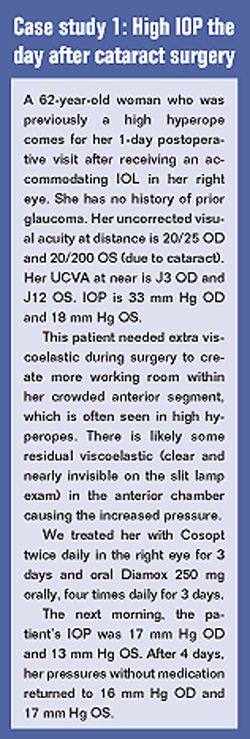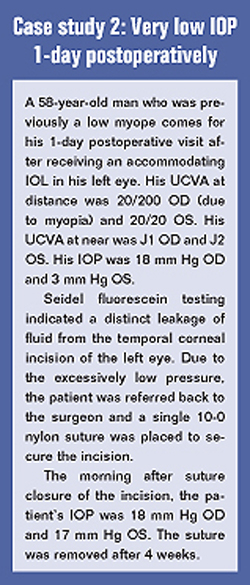Carefully check healing 1 day postop in cataract surgery patients
Cataract Surgery
|
|
|
With modern surgical techniques, 1-day postoperative patients will have recovered much of their vision and be quite content. However, they may not know what to expect and how quickly the full range of vision will be restored. It is our job to comanage their postoperative care and educate them along the way.
More and more primary care eye doctors are choosing to see their own patients for all of the postoperative visits, including the day after surgery. For those who are still building their comfort level, we encourage them to spend time with our practice learning.
The patients will look normal (no eye patch and no eye shield) and their operated eye will likely look normal as well (no injection, no bleeding and no soft tissue swelling). However, they are at the earliest and most critical stage of healing.
 |
The first questions we usually ask the patient are: “How was the surgery? Did you sleep well? How’s your vision coming along?”
With rare exception, patients report that the surgery was painless and easy, that they slept well (due to the mild intravenous sedation often given during surgery) and that they are seeing better already. We also like to provide encouragement, because healing can take time and their ultimate vision and visual quality comes gradually.
Positive reinforcement during visual acuity check
When checking the visual acuity, we start with larger than expected Snellen letters, typically the 20/100 level, and display only one line at a time. While most patients have sharp vision the day after surgery, those with dense cataracts may have postoperative corneal edema and a high degree of inflammation, which can limit vision initially. This is usually of no concern, because it resolves and the ultimate visual acuity is excellent.
After reading each line, we give a positive reinforcement: “That’s excellent, very good. How about trying to read these baby letters? Wow – now you’re showing off.” The patients judge their new vision by watching your reaction – if you are happy, then they are happy.
If the uncorrected visual acuity is less than 20/40, see if it improves with pinhole testing. We also like to do a brief manifest refraction on these patients, keeping in mind that there may be considerable refractive shift for 2 to 4 weeks after surgery.
For patients with presbyopia-correcting IOLs, such as accommodating IOLs, a check of intermediate/near acuity is done. Hold the reading card about newspaper distance away (about 2 feet from the eye) and start with large letters and work down. It takes time for the accommodating muscles to learn how to use the new IOL, and the near vision typically improves after a few months.
Gently check IOP
A properly cleaned and disinfected Goldmann applanation tip is critical, because we do not want to expose the patient to an infection risk. When checking IOP it is important to be gentle, because excessive pressure on the eye can give a false IOP reading and, even worse, can cause the freshly made incisions to leak.
 |
Similarly, we emphasize to the patients that they should be very gentle on their eyes with absolutely no eye rubbing for at least 1 week. The IOP on postoperative day 1 should be between about 8 mm Hg and 30 mm Hg.
A high IOP (greater than 30 mm Hg) after surgery may be due to retained viscoelastic. Most retained viscoelastics will be broken down and passed through the trabecular meshwork within the first week after surgery.
We give patients with high IOP topical pressure-lowering medications such as Cosopt (dorzolamide HCI, timolol maleate ophthalmic solution, Merck) and Alphagan (brimonidine tartrate, Allergan), as well as oral Diamox (acetazolamide, Duramed), 250-mg tablets four times daily for 3 days, and see them later the same day or the next day to re-check the IOP.
An excessively high pressure that is accompanied by pain, discomfort and nausea should be referred back to the surgeon for management. Under no circumstances should you try to tap the anterior chamber or try to release fluid via incisions, as this would pose a high infection risk or even cause the IOL position to shift.
Testing for a leaking incision
A low IOP (less than 8 mm Hg) may indicate a leaking surgical incision, and we can easily and safely test for this using the Seidel fluorescein test. There are typically two surgical incisions, a larger (approximately 2.8 mm wide) temporal corneal incision and a smaller (approximately 1.0 mm wide) accessory incision made a few clock hours away.
The Seidel test involves taking a sterile, dry fluorescein strip and applying a drop of saline to it to create a concentrated orange dye. The surgical incisions are painted with the concentrated orange fluorescein dye and observed. Any leaking fluid will cause the dye to become diluted and it will turn the characteristic yellowish-green color.
You may see a trickle of fluid running out of the incision. If the leakage is mild, placing a tight bandage contact lens on the eye and re-checking the Seidel fluorescein test the next day may be a good option. For a significant amount of leakage or for an IOP of 3 mm Hg or less, referring the patient back to the surgeon for possible suture closure of the incisions is recommended.
With good vision and a normal IOP, we turn our attention to the slit-lamp examination – the focus of our next column.
For more information:
- Uday Devgan, MD, FACS, is in private practice in Los Angeles, chief of ophthalmology at Olive View-UCLA Medical Center and an associate clinical professor at the Jules Stein Eye Institute at the UCLA School of Medicine. He can be reached at 19021 Wilshire Blvd. #900, Los Angeles, CA 90024; (310) 208-3937; fax: (310) 208-0169; www.cataractbook.com; e-mail: devgan@gmail.com. Dr. Devgan has no direct financial interest in the products mentioned in this article, nor is he a paid consultant for any companies mentioned.
- Tina Geis, OD, specializes in the preoperative evaluation and postoperative care of patients. She can be reached at 19021 Wilshire Blvd. #900, Los Angeles, CA 90024; (310) 208-3937; fax: (310) 208-0169; www.cataractbook.com; e-mail: drgeis@maloneyvision.com. Dr. Geis has no direct financial interest in the products mentioned in this article, nor is she a paid consultant for any companies mentioned.


